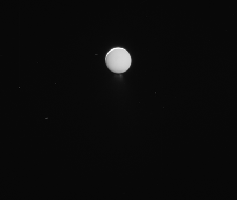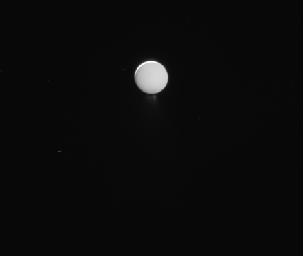
Click for larger animationThis movie sequence of images is from the last dedicated observation of the Enceladus plume by NASA's Cassini spacecraft.
The images were obtained over approximately 14 hours as Cassini's cameras stared at the active, icy moon. The view during the entire sequence is of the moon's night side, but Cassini's perspective Enceladus shifts during the sequence. The movie begins with a view of the part of the surface lit by reflected light from Saturn and transitions to completely unilluminated terrain. The exposure time of the images changes about halfway through the sequence, in order to make fainter details visible. (The change also makes background stars become visible.)
The images in this movie sequence were taken on Aug. 28, 2017, using Cassini's narrow-angle camera. The images were acquired at a distance from Enceladus that changed from 684,000 to 539,000 (1.1 million to 868,000 kilometers). Image scale changes during the sequence, from 4 to 3 miles (7 to 5 kilometers) per pixel.
The Cassini mission is a cooperative project of NASA, ESA (the European Space Agency) and the Italian Space Agency. The Jet Propulsion Laboratory, a division of Caltech in Pasadena, manages the mission for NASA's Science Mission Directorate, Washington. The Cassini orbiter and its two onboard cameras were designed, developed and assembled at JPL. The imaging operations center is based at the Space Science Institute in Boulder, Colorado.
The Cassini mission is a cooperative project of NASA, ESA (the European Space Agency) and the Italian Space Agency. The Jet Propulsion Laboratory, a division of Caltech in Pasadena, manages the mission for NASA's Science Mission Directorate, Washington. The Cassini orbiter and its two onboard cameras were designed, developed and assembled at JPL. The imaging operations center is based at the Space Science Institute in Boulder, Colorado.
For more information about the Cassini-Huygens mission visit https://saturn.jpl.nasa.gov and https://www.nasa.gov/cassini. The Cassini imaging team homepage is at https://ciclops.org.

 Planetary Data System
Planetary Data System













